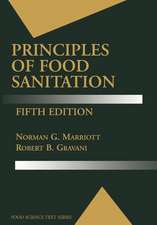Essentials of Food Sanitation: Food Science Text Series
Autor Norman G. Marriotten Limba Engleză Paperback – 31 aug 1997
Din seria Food Science Text Series
- 17%
 Preț: 502.96 lei
Preț: 502.96 lei - 17%
 Preț: 469.19 lei
Preț: 469.19 lei - 15%
 Preț: 549.39 lei
Preț: 549.39 lei - 20%
 Preț: 579.81 lei
Preț: 579.81 lei -
 Preț: 458.78 lei
Preț: 458.78 lei - 15%
 Preț: 566.10 lei
Preț: 566.10 lei - 13%
 Preț: 358.76 lei
Preț: 358.76 lei - 15%
 Preț: 635.76 lei
Preț: 635.76 lei -
 Preț: 482.23 lei
Preț: 482.23 lei -
 Preț: 392.37 lei
Preț: 392.37 lei -
 Preț: 398.35 lei
Preț: 398.35 lei - 15%
 Preț: 508.60 lei
Preț: 508.60 lei - 15%
 Preț: 508.75 lei
Preț: 508.75 lei - 15%
 Preț: 587.39 lei
Preț: 587.39 lei - 18%
 Preț: 965.83 lei
Preț: 965.83 lei -
 Preț: 393.13 lei
Preț: 393.13 lei - 15%
 Preț: 532.70 lei
Preț: 532.70 lei - 15%
 Preț: 593.26 lei
Preț: 593.26 lei -
 Preț: 474.31 lei
Preț: 474.31 lei - 15%
 Preț: 658.05 lei
Preț: 658.05 lei - 15%
 Preț: 600.74 lei
Preț: 600.74 lei - 18%
 Preț: 971.22 lei
Preț: 971.22 lei - 15%
 Preț: 477.74 lei
Preț: 477.74 lei - 18%
 Preț: 1010.33 lei
Preț: 1010.33 lei - 15%
 Preț: 477.74 lei
Preț: 477.74 lei - 15%
 Preț: 574.25 lei
Preț: 574.25 lei
Preț: 396.40 lei
Nou
Puncte Express: 595
Preț estimativ în valută:
75.86€ • 78.91$ • 62.63£
75.86€ • 78.91$ • 62.63£
Carte tipărită la comandă
Livrare economică 14-28 aprilie
Preluare comenzi: 021 569.72.76
Specificații
ISBN-13: 9780412080111
ISBN-10: 0412080117
Pagini: 344
Ilustrații: 344 p. 34 illus.
Dimensiuni: 178 x 254 x 15 mm
Greutate: 0.61 kg
Ediția:Softcover reprint of the original 1st ed. 1997
Editura: Springer Us
Colecția Springer
Seria Food Science Text Series
Locul publicării:New York, NY, United States
ISBN-10: 0412080117
Pagini: 344
Ilustrații: 344 p. 34 illus.
Dimensiuni: 178 x 254 x 15 mm
Greutate: 0.61 kg
Ediția:Softcover reprint of the original 1st ed. 1997
Editura: Springer Us
Colecția Springer
Seria Food Science Text Series
Locul publicării:New York, NY, United States
Public țintă
ResearchCuprins
1 Sanitation: definitions and regulations.- Importance of sanitation.- Definition and application to food industry and foodservice.- Current regulations.- Voluntary sanitation programs.- Establishing sanitary practice.- 2 Microorganisms.- Common microorganisms.- Growth phases of microorganisms.- What causes microbes to grow?.- How food is spoiled.- Foodborne illness.- Destroying microbes.- Inhibiting growth of microbes.- Tests to detect and count microbes.- 3 Sources of food contamination.- The chain of infection.- How foods become contaminated.- Other sources of contamination.- How to prevent and control contamination of foods.- 4 Personal hygiene and food handling.- Personal hygiene.- Hygienic food handling.- 5 Cleaning compounds.- Types of soil.- How soil is attached.- How cleaning compounds work.- Types of cleaning compounds.- Additives to cleaning compounds.- Scouring compounds.- Choosing a cleaning compound.- Handling and storing cleaning compounds.- Chemical contamination of food.- 6 Sanitizing methods.- Heat.- Radiation.- Chemicals.- 7 Cleaning and sanitizing systems.- Costs.- Selecting a system.- Cleaning equipment.- Sanitizing equipment.- Lubrication equipment.- 8 Waste disposal.- Strategy for waste disposal.- Solid-waste disposal.- Liquid-waste disposal.- 9 Pest control.- Insects.- Insect destruction.- Rodents.- Birds.- Use of pesticides.- Integrated pest management.- 10 Quality Assurance and Hazard Analysis Critical Control Point (HACCP).- Quality assurance (QA).- Total quality management (TQM) and hazard analysis critical control points (HACCP).- HACCP principles.- Developing and implementing HACCP.- 11 Dairy processing and product sanitation.- Major pathogens.- Plant construction.- Types of soil.- Sanitation management.- Cleaning equipment.- 12 Meat and poultry sanitation.- Common pathogens.- Sanitation management.- Cleaning practices for meat and poultry plants.- Cleaning compounds for meat and poultry plants.- Sanitizers for meat and poultry plants.-Personal hygiene and work habits of employees.- Sanitation procedures.- Troubleshooting tips.- 13 Seafood sanitation.- Sources of seafood contamination.- Sanitation management.- Plant construction.- Recovering by-products.- Voluntary inspection programs.- 14 Fruit and vegetable processing and product sanitation.- Reducing contamination.- Sanitation management.- Plant construction.- Cleaning processing plants.- Cleaners and sanitizers.- Cleaning procedures.- Evaluation.- 15 Beverage plant sanitation.- Focus on yeasts.- Sanitation management.- Nonalcoholic beverage plant sanitation.- Brewery sanitation.- Winery sanitation.- Distillery sanitation.- 16 Low-moisture-food sanitation.- Facility design and construction.- Receiving and storing raw materials.- Cleaning processing plants.- 17 Sanitary food handling in foodservice.- Sanitary procedures for food preparation.- Reducing contamination.- Cleaning and sanitizing.- Sanitation management and training.- 18 Foodservice control points.- Buying ingredients.- Receiving and storing ingredients.- Preparing, serving, and reheating foods.- Facility and equipment design.- 19 Management and sanitation.- Management’s role.- Hiring and training employees.- Total quality management.- Appendices 1. Where to get more information about food safety and sanitation: agencies, associations, and consumer organizations.- 2. About pathogenic microorganisms.- 3. Safe cooking temperatures for meat and poultry.- 4. Cold storage times for meat and poultry.- Answers to study questions.

























